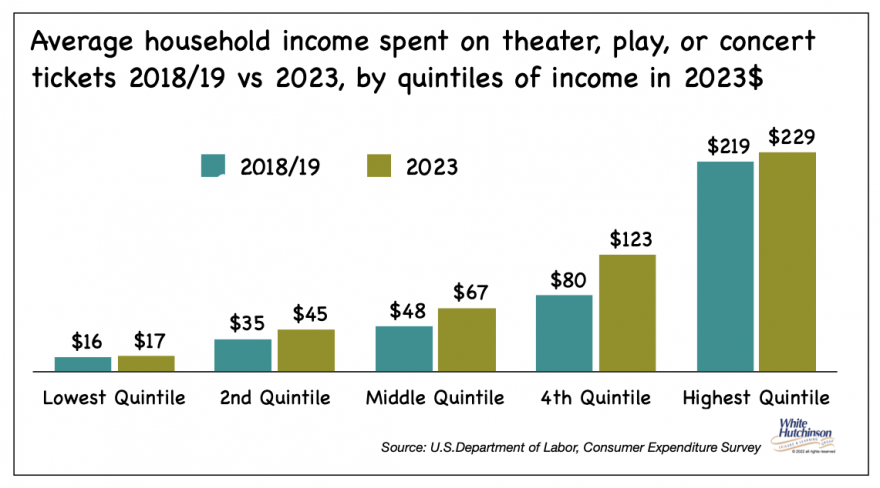
Vol. XXIV, No. 8, December 2024
The growing market share of live events
When comparing both 2023 time use data from the American Time Use Survey (ATUS) and household spending from the Consumer Expenditure Survey to the same data pre-pandemic, we spotted what could be a significant trend. Both time spent and spending on location-based live events that include live theater, concerts, opera, other performing arts, and live sporting events are growing. In contrast, time spent and spending at non-live LBE venues such as family entertainment centers and theme parks is flat. The live events sector is experiencing a significant post-pandemic resurgence
Spending on performing arts, including theater, opera, and concerts, and on live sporting events was up significantly, whereas spending on parks and museums that include family entertainment centers was basically flat. Spending on movie theater tickets was significantly down, almost in half.

Time spent at performing arts and live sporting events was up.

Live sports attendance records have been shattered across various leagues, including Major League Baseball (MLB), the National Basketball Association (NBA), the National Hockey League (NHL), Major League Soccer (MLS), and the National Women's Soccer League (NWSL).
Average household spending on live performing arts and for live sporting events was up for every household based on the householder's age except for age 65+.

Likewise, average household spending on live performing arts was up for every quintile of household income.

Part of the shift to live events may be driven by our human need for social embeddedness, especially the communal experience of being in a crowd. The need for social embeddedness is as important to people as the need to belong. The opportunity to be in a crowd was lacking during the early pandemic days, possibly heightening the desire for it post-pandemic (see last month's article on the power of crowds). This year's poll by Non Plus Ultra found that approximately 72% of respondents prefer in-person events over virtual ones, reflecting a widespread desire for physical gatherings after extended periods of isolation driving a resurgence in attendance at concerts, festivals, and other live performances.
Another explanation for the shift to live events may be the shift in peoples' identity from "I am what I own" to "I am what I do." Now, most people would rather be known for their experiences than their possessions. And the more status-worthy and unique experiences you can have and post, the greater your social capital. So, people are constantly seeking new and unique experiences that their friends and social media followers haven't yet enjoyed, and they will be envious of them and wish they could have done them. Signaling your identity and gaining social capital has shifted to the experiences we have. In fact, for many people, especially younger adults, if an experience isn't sharable,it probably isn't worth doing. Due to the uniqueness and limited time of most live events, often for a single day, they garner greater status. and are more sought after than low-status, long-term experiences such as attending non-live location-based entertainment venues such as family entertainment centers or theme parks.
Subscribe to monthly Leisure eNewsletter


